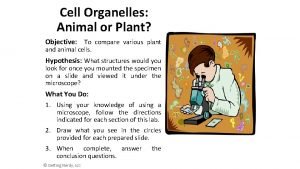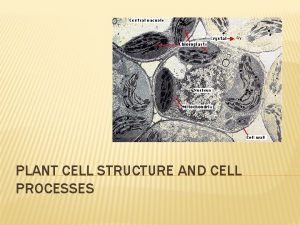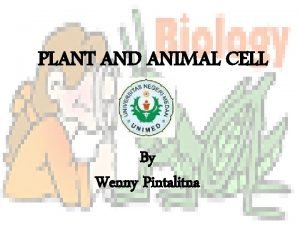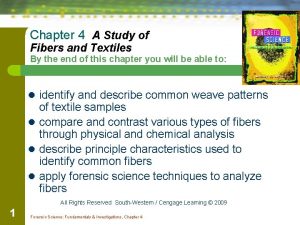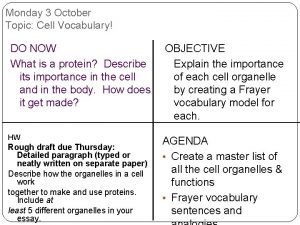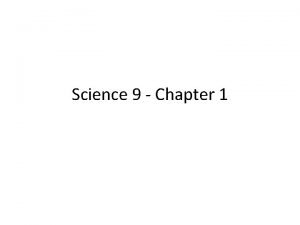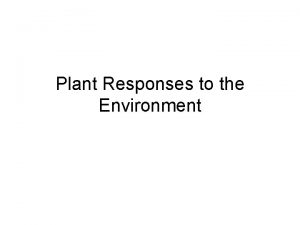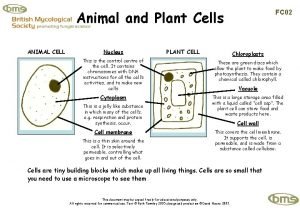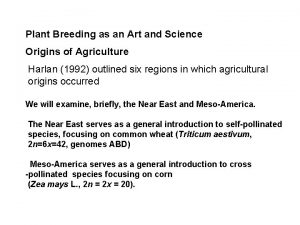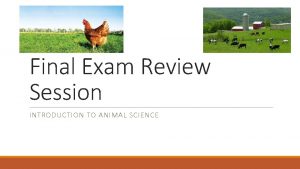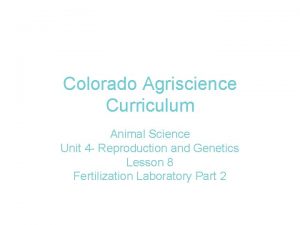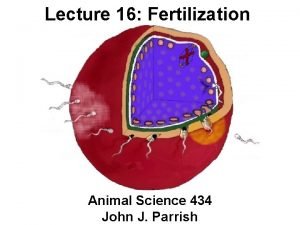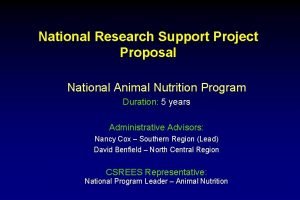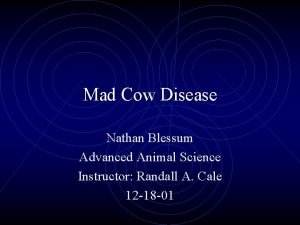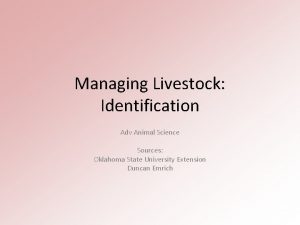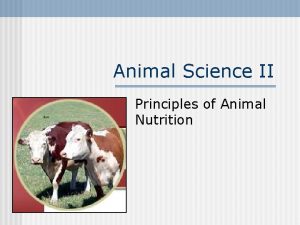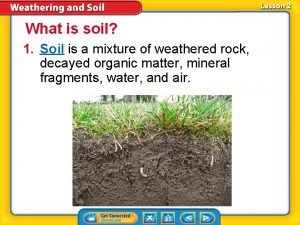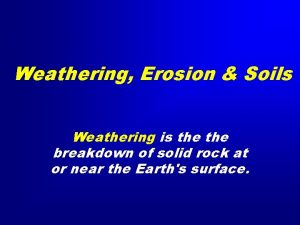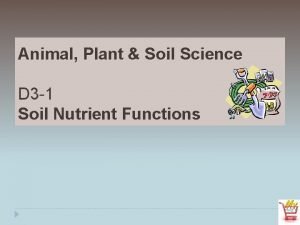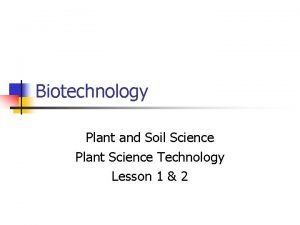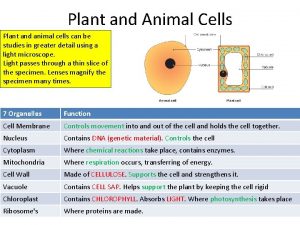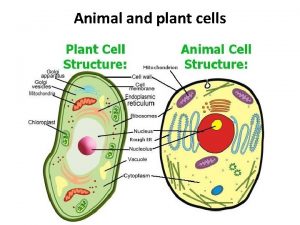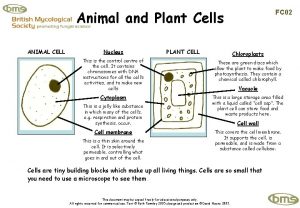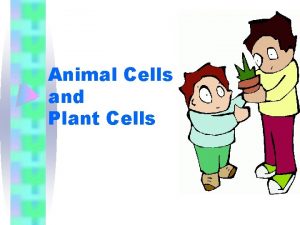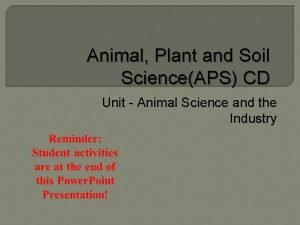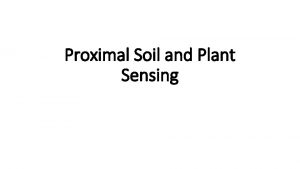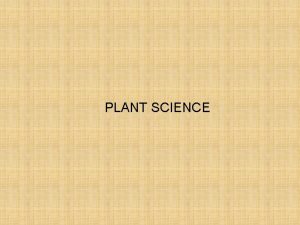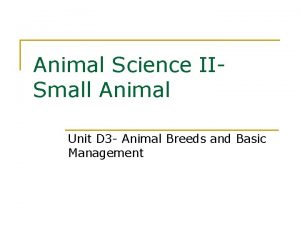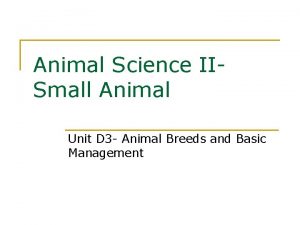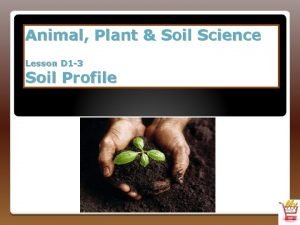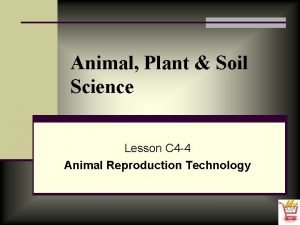Animal Plant Soil Science D 2 3 Soil





































































- Slides: 69

Animal, Plant & Soil Science D 2 -3 Soil Erosion & Calculating Soil Loss

Interest Approach l Ask students who they would contact in case of a burglary. They will likely answer the police or detectives. It is the job of law enforcement officers to apprehend the thief. Soil erosion is a thief that steals the precious soil a producer needs to raise a profitable crop. In order for the producer to stop soil erosion, he or she must first understand how the soil has eroded.

Interest Approach l Ask students to identify visible signs of erosion. They may have been fishing and noticed muddy water or driving and had difficulty seeing because of a dust storm. They should be able to give many examples. Ask students where they think the soil came from. Ask if any problems are associated with this movement of soil. Ask what could be done to reduce this soil erosion. When discussion is complete, cover the learning objectives with the students as you begin the lesson.

Objectives l 1 Define soil erosion and describe the two classes of erosion. l 2 Identify the causes of soil erosion. l 3 Explain the ways in which different types of wind erosion occur and the associated problems. l 4 Distinguish between the different types of water erosion.

Objectives l 5 Estimate the amount of soil loss from water erosion using the Universal Soil Loss Equation. l 6 Identify urban management practices that reduce soil erosion. l 7 Identify agricultural management practices that minimize soil erosion. l 8 Identify the environmental and economic impacts of soil erosion.

Terms l _ accelerated erosion l _ saltation l _ contour l _ sediment l _ deposition l _ sheet erosion l _ detachment l _ soil erosion l _ glacial erosion l _ splash erosion l _ gully erosion l _ surface creep l _ land slippage l _ suspension l _ natural (geologic) l _ transport erosion l _ rill erosion l _ runoff l _ water erosion l _ wind erosion

Terms l conservation tillage l mulching l contour tillage l silt fences l cover crops l strip-cropping l diversion ditches l T value l fallow l terrace l graded terraces l Universal Soil Loss l grassed strips Equation (USLE) l wind breaks l grassed waterway l level terraces

What is soil erosion, and what are the two classes of erosion? l I. Soil erosion is the process by which soil is moved. When soil is eroded, it may become pollution in the water or air. Land that is eroded loses fertility. Vegetation and other coverings help prevent soil erosion. The two basic classes of erosion are natural (geologic) and accelerated.

What is soil erosion, and what are the two classes of erosion? l A. Natural (geologic) erosion occurs in nature without human influence. This type of erosion has changed the landscape of the earth. For example, it has rounded off mountains and filled in valleys. Deposits of eroded soil have formed new, highly fertile areas, such as the Mississippi Delta.

What is soil erosion, and what are the two classes of erosion? l B. Accelerated erosion removes topsoil at an excessive rate and usually results from human activity on the land. Such activity includes construction and plowing. Accelerated erosion causes large losses of soil from farm lands and loss of fertility.

What are the causes of soil erosion, and what are the steps in the erosion process? l II. Erosion is caused by many different weather factors, such as wind, water, and glacial movement. When land is cleared of protective covering, it is much more susceptible to erosion.

What are the causes of soil erosion, and what are the steps in the erosion process? • A. There are four basic types of erosion. • 1. Wind erosion is the loss of soil due to the movement of wind over the land. It usually occurs in dry climates where the soil is loose. Wind erosion occurs on newly plowed fields, construction sites cleared by large equipment, and land where vegetation has been grazed too short.

What are the causes of soil erosion, and what are the steps in the erosion process? • 2. Water erosion is the loss of soil due to water movement. It is the major cause of soil loss in North America. Water erosion occurs when excess rainfall creates runoff that carries soil away. Runoff occurs when rain falls faster than it can be absorbed into the soil. Runoff water carries soil particles as it makes its way into streams and rivers. This action causes water pollution and sediment. Sediment is the deposition of soil in the bottom of streams, riverbeds, ditches, etc.

What are the causes of soil erosion, and what are the steps in the erosion process? l 3. Glacial erosion occurs when the front edge of a glacier pushes soil, rocks, fallen trees, and other materials. Soil erosion from glaciers is of minor importance except in areas where glaciers exist. Glacial erosion was prevalent during the Ice Age, but glacial erosion has greatly diminished as the planet has warmed.

What are the causes of soil erosion, and what are the steps in the erosion process? l 4. Land slippage occurs on sloping land that is wet. Soil becomes saturated with water and slips down a hillside or mountain slope. Land slippage is also known as a mudslide or landslide. Banks along highways, streams, and ocean fronts are often subject to slides.

What are the causes of soil erosion, and what are the steps in the erosion process? l B. The process of soil erosion follows a simple, systematic progression each and every time. The erosion process involves three distinct steps. The first step is the loosening of soil particles. The second step is the moving of soil particles. The third step is the placement of soil particles. Terms that describe these three steps are detachment, transport, and deposition.

What are the causes of soil erosion, and what are the steps in the erosion process? l 1. Detachment is the step in which the impact of raindrops shatters surface aggregates and loosens soil particles. Some of the particles float into soil voids, sealing the soil surface so water cannot readily infiltrate the soil. The scouring action of running water also detaches some soil particles.

What are the causes of soil erosion, and what are the steps in the erosion process? l 2. Transport is the step during which the detached soil grains move in flowing water and are carried down slopes. l 3. Deposition is the step during which the soil is deposited as the water slows down.

What are the causes of soil erosion, and what are the steps in the erosion process? • C. Four factors determine how susceptible a soil is to soil erosion. • 1. Structure and texture—Soil structure influences infiltration of water. Good soil structure allows water to enter the soil, thus reducing water runoff. Soil texture has two effects on soil erosion. ▫ ▫ a. Texture affects the rate at which water can enter the soil. Less water running on the surface of the soil means less soil can be transported. b. Texture influences the ease of detachment of soil particles. Soil particles of different sizes vary in how easily they can be detached. Silt particles are the most easily detached.

What are the causes of soil erosion, and what are the steps in the erosion process? • 2. Slope—Two components determine slope. They are length and grade. ▫ ▫ a. On a long slope, a greater surface area is collecting water, increasing flow volume. Running water can also pick up speed as it flows down a long slope. b. Water runoff velocity will increase as slope grade increases. This causes an increase in the erosive energy of the runoff water.

What are the causes of soil erosion, and what are the steps in the erosion process? l 3. Surface roughness—A rough soil surface slows the downhill flow of water. Surface roughness depends a great deal on the tillage practice used on the land. In conventional tillage, the seedbed is left smooth with very few ridges. Chisel plowing leaves the seedbed rough. Tillage across slopes, or on the contour, also acts to slow water flow.

What are the causes of soil erosion, and what are the steps in the erosion process? l 4. Soil cover—Bare soil is fully exposed to the erosive forces of raindrop impact and the scouring of running water. Soil cover reduces the energy available to cause erosion to the soil. A mulch, a cover, or crop residue absorbs the energy of the falling raindrop. This reduces soil detachment.

What are the ways in which different types of wind erosion occur, and what are the associated problems? l III. Wind erosion causes air pollution, produces highway safety hazards, and fills drainage ditches. It occurs when persistent or frequent high-velocity winds and a dry, residue-free soil surface exist. Soil is moved by suspension, saltation, and surface creep.

What are the ways in which different types of wind erosion occur, and what are the associated problems? l A. Suspension occurs when very small soil particles become airborne and enter the main airstream. They are carried in the same general direction as the wind. Because the soil particles are small, they remain in suspension.

What are the ways in which different types of wind erosion occur, and what are the associated problems? l B. Saltation occurs when the wind lifts medium-sized soil particles into the air. They are too heavy to remain in suspension, so they fall to the ground, loosening other soil particles. This process repeats itself.

What are the ways in which different types of wind erosion occur, and what are the associated problems? l C. Surface creep occurs as saltation takes place. The soil particles that are too heavy to be moved by saltation are moved along the surface by the impact of soil particles being displaced by saltation.

What are the different types of water erosion? l IV. Four kinds of water erosion can occur. They are splash erosion, sheet erosion, rill erosion, and gully erosion.

What are the different types of water erosion? l A. Splash erosion is the direct movement of soil by splashing. A soil grain can be thrown as far as 5 feet by a raindrop splash. Splashed particles fill the voids between other aggregates and seal the soil surface.

What are the different types of water erosion? • B. Sheet erosion results when thin layers, or sheets, of soil are worn away. Sheet erosion can occur on nearly level land or on sloping land. If muddy water is moving off a field, sheet erosion is occurring. This type of erosion may go unnoticed since no channels form. However, it may be just as problematic as erosion that is more apparent.

What are the different types of water erosion? l C. Rill erosion usually occurs on sloping land, where small channels are formed by running water. The signs of rill erosion can be masked by normal tillage practices.

What are the different types of water erosion? • D. Gully erosion occurs when rills continue to wash away and become more severe. It is more likely on steeper slopes and cannot be smoothed by normal tillage practices. Gullies are so large the equipment cannot cross them. Gullies usually begin to form near the bottoms of slopes or on steep slopes.

How is the amount of soil loss from water erosion estimated? l I. Erosion is a form of work, which requires energy.

How is the amount of soil loss from water erosion estimated? l A. Energy for water erosion comes from the energy of a falling raindrop or running water. l 1. The energy of a falling raindrop relates to its size and especially to its speed. A 2 -inchper-hour rainfall has the same energy as a 1 pound object falling 47 feet onto 1 square foot of soil. l 2. The erosive energy of running water depends on its volume and speed of flow.

How is the amount of soil loss from water erosion estimated? l B. Using various soil loss factors, the Universal Soil Loss Equation (USLE) has been developed to predict the average soil loss from sheet and rill erosion on a specific site. It was developed over several years by the Natural Resources Conservation Service. l 1. Producers can use the equation to estimate the rate of soil loss on their land compare that rate with a soil’s T value is soil loss tolerance value (i. e. , the amount of soil loss that can be tolerated by that soil type). Each soil type has its own T value.

How is the amount of soil loss from water erosion estimated? l 2. The formula for USLE is A = R × K × LS × C × P. Each letter in the formula represents a specific soil loss factor. u a. Average annual soil loss (A)—“A” represents the average annual soil erosion loss in tons per acre. This factor should be less than the T value for the soil type.

How is the amount of soil loss from water erosion estimated? u b. Rainfall (R)—“R” represents the erosion potential inherent in the rainfall patterns of a particular area. The factors were developed from U. S. Weather Service data taken over a 22 -year period.

How is the amount of soil loss from water erosion estimated? u c. Soil erodibility (K)—This factor reflects the fact that various soils erode at different rates because of different physical characteristics, such as texture, structure, organic matter content, and soil depth. Each different soil type has a specific K value.

How is the amount of soil loss from water erosion estimated? u d. Slope length and steepness (LS)— This factor represents the erosion potential for a particular combination of slope length and slope steepness. Slope length is not the distance from the highest point in the field to the lowest. It must be determined where the water will flow. Concentrate on natural water flow areas. Slope is determined by dividing the rise of the land by the run of the land.

How is the amount of soil loss from water erosion estimated? l e. Cropping factor (C)—This reflects the reduction in soil erosion when a specific cropping system is compared with continuous fallow (where the soil is tilled, but no crop is grown). The C factor of 1. 0 is assigned to continuous fallow. C factors are determined by the climatic conditions of a region, crop rotation used, tillage methods used, and crop residue on the field.

How is the amount of soil loss from water erosion estimated? u f. Conservation practice (P)—This represents the reduction of soil erosion due to the implementation of various conservation practices, such as contour farming, strip cropping, and terracing.

What are some management practices that can be implemented in urban areas to reduce soil erosion? l II. In urban areas, the main concern is keeping the soil covered to control water runoff. This applies to construction sites, roads, parking lots, and recreational areas. Several practices are used to help conserve soil in urban areas.

What are some management practices that can be implemented in urban areas to reduce soil erosion? l A. Mulching is placing a layer of straw, burlap, or other material on the top of soil to protect it from wind and water. Mulch helps hold water and reduces the impact of water flow.

What are some management practices that can be implemented in urban areas to reduce soil erosion? l B. Silt fences are placed at the bottoms of slopes to hold the soil and still allow water to flow. This keeps sediment out of streams and lakes and prevents the loss of soil. Silt fences may be made out of bales of hay, plastic strips, or other materials.

What are some management practices that can be implemented in urban areas to reduce soil erosion? l C. Cover crops—Vegetation can be planted on excavated soil to hold it in place. Winter grass can be planted in the fall on new lawn areas to prevent erosion until the following spring, when a permanent sod can be established.

What are some management practices that can be implemented in urban areas to reduce soil erosion? l D. Building on the contour—Streets, buildings, and other structures can be located on the contour of the land to diminish water flow.

What are some management practices that can be implemented in urban areas to reduce soil erosion? l E. Stabilizing banks—Creeks and roadsides often have banks that will quickly erode. Riprap, fabrics, straw, vegetation, and concrete are some materials used to stabilize banks.

What are some management practices that can be implemented in urban areas to reduce soil erosion? l F. Planting trees and shrubs— Trees and shrubs can be planted in areas where erosion is possible. The roots hold the soil. The limbs and leaves on the tree slow the impact of rain, and fallen leaves cover the ground.

What are some management practices that can be implemented in urban areas to reduce soil erosion? l G. Storm water management—Curbs, ditches, and other structures may be installed to properly manage excess precipitation.

What management practices help to minimize soil erosion? l III. Preventing or stopping soil erosion is a major goal of every producer. Once a producer understands the causes of soil erosion and has estimated the amount of soil loss on his or her farm, a plan of action must be developed.

What management practices help to minimize soil erosion? l A. All methods of controlling water erosion are based on one of the following three actions: l 1. Reducing raindrop impact to lessen detachment l 2. Reducing or slowing water runoff to lessen detachment by scouring and reduce the amount of soil that can be transported l 3. Carrying excess water off a field safely

What management practices help to minimize soil erosion? l B. There are several management practices and tools that a land owner can use to reduce and prevent soil erosion on property.

What management practices help to minimize soil erosion? l 1. Conservation tillage— Conservation tillage consists of tillage practices that leave crop residues on a rough soil surface to reduce erosion. These practices dramatically reduce sheet and rill erosion. Conservation tillage is also the lowest conservation method per ton of soil saved.

What management practices help to minimize soil erosion? l 2. Soil cover—Whenever soil is worked or exposed, covering the surface with mulch or vegetation reduces erosion. Fields may be planted in winter-cover crops after fall harvest. The cover crop adds fertility and protects the soil from erosion.

What management practices help to minimize soil erosion? l 3. Crop rotation—This practice reduces erosion if close-growing crops, such as small grains or forages, are included. These close-growing crops reduce the detachment and transport energy of water. They also improve the physical properties of the soil so that water seeps into the soil better.

What management practices help to minimize soil erosion? l 4. Grassed waterways— A grassed waterway is a shallow, sodded, wide ditch that runs down a slope. It is designed to carry excess water off a field safely.

What management practices help to minimize soil erosion? l 5. Grassed strips—Small strips covered with grass may be left near plowed areas. This diminishes the flow of water and helps keeps gullies from forming.

What management practices help to minimize soil erosion? l 6. Contour tillage—Contour tillage is tillage following the contours of a slope, rather than up and down a slope. This practice works best on permeable soils in areas of low-intensity rainfall.

What management practices help to minimize soil erosion? l 7. Strip cropping—Strip cropping is planting different types of crops in alternating strips to prevent wind or water erosion. Strips are usually planted on a slope contour or across the direction of the prevailing wind.

What management practices help to minimize soil erosion? l 8. Improving organic matter—Improving the organic matter content of a soil can greatly reduce erosion because moisture will enter the soil more quickly.

What management practices help to minimize soil erosion? l 9. Terrace—A terrace is a low ridge and shallow channel running across a slope or on the contour to capture water so it can soak into the soil. u u a. Level terraces parallel the slope and do not empty into a waterway. These terraces are used where soil is permeable enough that water can seep in once it is captured in a terrace. b. Graded terraces are needed where water cannot soak in enough. These terraces slope gently towards a waterway or an underground tile outlet.

What management practices help to minimize soil erosion? l 10. Diversion ditches—Small ditches may be built across slopes to slow water movement and divert it into a safe outlet. They are similar to grassed waterways but may be lined with riprap or other material.

What management practices help to minimize soil erosion? l 11. Wind breaks— Rows of trees may be planted to diminish blowing wind and help prevent wind erosion.

What are the environmental and economic impacts of soil erosion? l IV. According to some scientists, soil erosion is considered the second biggest environmental problem the world faces. (The first is population growth. ) A 2006 Cornell University study, combining statistics on soil erosion from more than 125 sources, reports the following:

What are the environmental and economic impacts of soil erosion? l A. The United States is losing soil 10 times faster, and China and India are losing soil 30 to 40 times faster, than the natural replenishment rate. l B. The economic impact of soil erosion in the United States costs the nation about $37. 6 billion each year in productivity losses. Damage from soil erosion worldwide is estimated to be $400 billion per year.

What are the environmental and economic impacts of soil erosion? l C. As a result of erosion over the past 40 years, 30 percent of the world’s arable land has become unproductive. l D. About 60 percent of soil that is washed away ends up in rivers, streams, and lakes, making waterways more prone to flooding and to contamination from soil’s fertilizers and pesticides.

What are the environmental and economic impacts of soil erosion? l E. Soil erosion reduces the ability of soil to store water and support plant growth, thereby reducing its ability to support biodiversity. l F. Erosion promotes critical losses of water, nutrients, soil organic matter, and soil biota, harming forests, rangeland, and natural ecosystems.

What are the environmental and economic impacts of soil erosion? l G. Erosion increases the amount of dust carried by wind, which not only acts as an abrasive and air pollutant but also carries about 20 human infectious disease organisms, including anthrax and tuberculosis.

REVIEW • 1. What is soil erosion, and what are the two classes of erosion? • 2. What are the causes of soil erosion, and what are the steps in the erosion process? • 3. What are the ways in which different types of wind erosion occur, and what are the associated problems? • 4. What are the different types of water erosion?

REVIEW l 5. How is the amount of soil loss from water erosion estimated? l 6. What are some management practices that can be implemented in urban areas to reduce soil erosion? l 7. What management practices help to minimize soil erosion? l 8. What are the environmental and economic impacts of soil erosion?
 Advantages of fertilizers
Advantages of fertilizers My favorite subject science
My favorite subject science Living soil vs dead soil
Living soil vs dead soil What are the four spheres of the earth
What are the four spheres of the earth Define plant breeding
Define plant breeding Taichum
Taichum Plant introduction in plant breeding
Plant introduction in plant breeding Tronsmo plant pathology and plant diseases download
Tronsmo plant pathology and plant diseases download Tronsmo plant pathology and plant diseases download
Tronsmo plant pathology and plant diseases download Albugo eye
Albugo eye Animal and plant cell similarities
Animal and plant cell similarities Whats the difference between plant and animal cells
Whats the difference between plant and animal cells Plant cell animal cell venn diagram
Plant cell animal cell venn diagram Plant cell vs animal cell venn diagram
Plant cell vs animal cell venn diagram Cell theory foldable
Cell theory foldable Cloroplasto
Cloroplasto Plant cell and animal cell diagram
Plant cell and animal cell diagram What is the function of vacuole in the cell
What is the function of vacuole in the cell Plant animal cell
Plant animal cell Plant cell under electron microscope labelled
Plant cell under electron microscope labelled Plant or animal cell
Plant or animal cell Plant and animal cells
Plant and animal cells Plankton is animal or plant
Plankton is animal or plant Chapter 4 a study of fibers and textiles review answers
Chapter 4 a study of fibers and textiles review answers Simple vs complex carbs
Simple vs complex carbs Group of multicellular oxygen producers
Group of multicellular oxygen producers Plant and animal cell jeopardy
Plant and animal cell jeopardy Cheek cell
Cheek cell Idealized animal cell and plant cell
Idealized animal cell and plant cell Structure of cell wall
Structure of cell wall Structure of cell
Structure of cell Plant vs animal cells
Plant vs animal cells Whats the difference between plant and animal cells
Whats the difference between plant and animal cells Plant and animal cells
Plant and animal cells Animal and plant reproduction venn diagram
Animal and plant reproduction venn diagram Choose a plant or animal
Choose a plant or animal Plant and animal responses
Plant and animal responses Hair morphology
Hair morphology Cell theory contributors
Cell theory contributors Chapter 7-1 life is cellular answer key
Chapter 7-1 life is cellular answer key What is the gooey liquid in plant and animal cells
What is the gooey liquid in plant and animal cells What cell is this
What cell is this Similarities between animal rights and animal welfare
Similarities between animal rights and animal welfare Soil temperature ppt
Soil temperature ppt Pure line selection
Pure line selection Animal nutrition grade 11
Animal nutrition grade 11 Animal science final exam
Animal science final exam Colorado agriscience curriculum
Colorado agriscience curriculum J
J Reptilenesia animal science
Reptilenesia animal science Animal science career cluster
Animal science career cluster Animal science merit badge worksheet
Animal science merit badge worksheet Project proposal in animal science
Project proposal in animal science Advanced animal science
Advanced animal science Advanced animal science
Advanced animal science Damron introduction to animal science download
Damron introduction to animal science download Adv animal science
Adv animal science Principles of animal nutrition
Principles of animal nutrition Social science vs natural science
Social science vs natural science What are the three branches of science
What are the three branches of science Natural and physical science
Natural and physical science Applied science vs pure science
Applied science vs pure science Anthropology vs sociology
Anthropology vs sociology Extra credit
Extra credit Why environmental science is an interdisciplinary science
Why environmental science is an interdisciplinary science Julie lundquist
Julie lundquist Soft science definition
Soft science definition Soil
Soil Soil is a mixture of
Soil is a mixture of Pedalfer soil
Pedalfer soil


















